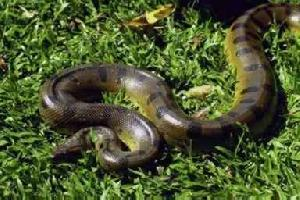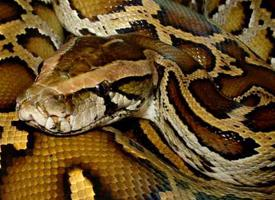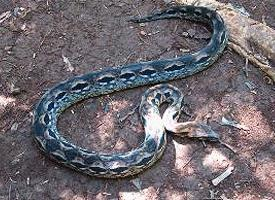
Greutăți și măsuri
| Lungime | de la 5 la 10 m |
|---|---|
| Greutate | de la 250 la 300 kg |
Descrierea animalului
The Green Anaconda (Eunectes murinus), often simply referred to as the anaconda, is one of the most fascinating and formidable creatures inhabiting the freshwater rivers and swamps of South America, particularly abundant in the Amazon and Orinoco basins. This species holds the title of the world's heaviest and one of the longest snakes, a fact that has embedded it deeply into the lore and fear of many cultures, often exaggerated in tales and legends.Characterized by its robust and muscular body, the Green Anaconda can reach lengths of up to 30 feet (9 meters), although the average size is usually a bit smaller, with females significantly outgrowing males. The scales of this magnificent reptile are predominantly olive green, providing excellent camouflage in its murky aquatic habitats. They are adorned with black blotches along the length of the body, further aiding in blending with the shadowy waters and dense vegetation. The skin is smooth and glossy, which helps in minimizing resistance while swimming.
The head of the Green Anaconda is small in comparison to its massive body, with eyes and nostrils positioned on top, allowing it to breathe and observe while the rest of the body remains submerged. This adaptation is crucial for its ambush predatory lifestyle. Its jaws are equipped with sharp, backward-facing teeth, designed to grasp slippery prey such as fish, birds, and even large mammals like capybaras and caimans. Unlike many predators, anacondas do not kill their prey with venom but through constriction, wrapping their powerful bodies around the victim and tightening their grip until suffocation.
Green Anacondas are semi-aquatic and are most adept in the water, where they can move with surprising speed and agility, thanks to their muscular build and streamlined shape. However, they are also capable of moving on land, though with less grace, often traveling between different bodies of water or in search of food.
Reproduction in Green Anacondas involves a fascinating phenomenon known as "breeding balls," where multiple males, sometimes up to a dozen, wrap around a single female in a competitive display, each vying to mate with her. This can last for several weeks, after which the female gives birth to live young, a rarity among snakes. The neonates are independent from birth, equipped with the skills and instincts necessary for survival.
Despite their fearsome reputation, Green Anacondas are not considered a significant threat to humans and rarely attack unless provoked or threatened. However, their habitats are increasingly under threat from human activities, particularly habitat destruction and the exotic pet trade. While they are not currently listed as endangered, their populations are under watch, and conservation efforts are necessary to ensure their survival.
Intriguing, majestic, and somewhat mysterious, the Green Anaconda continues to captivate the imagination of people around the globe, embodying the untamed and primal nature of the South American wilderness.
Animale similare
Fotografii noi cu animale
Top 10 animale
- Diana monkey (Cercopithecus diana)
- Dolphin gull (Leucophaeus scoresbii)
- Galápagos tortoise (Geochelone nigra complex)
- Moustached guenon (Cercopithecus cephus)
- Japanese spider crab (Macrocheira kaempferi)
- Colossal squid (Mesonychoteuthis hamiltoni)
- Fox tapeworm (Echinococcus multilocularis)
- Stone loach (Barbatula barbatula)
- Japanese macaque (Macaca fuscata)
- Barbary macaque (Macaca sylvanus)


